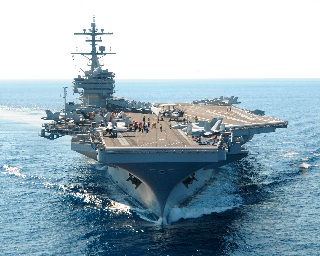The Romney campaign is moving full steam ahead with a new radio ad that repeats a misleading debate claim by Romney that the size of the Navy’s fleet is the smallest it has been since 1917. The number of ships is actually up a bit since 2007 under President George W. Bush.

Moreover, Navy officials say it’s silly to compare the size of the fleet in 1917 with that of today, because the mission and capabilities of today’s nuclear-powered aircraft carriers and nuclear submarines are vastly different than that of the gunboats and coal-powered dreadnaughts of 1917, when the shift to oil power was just starting.
The radio ad is running in Florida and Virginia — both are swing states but also big ship-building states. The newest nuclear-powered carrier, the USS Gerald R. Ford, is currently under construction in Newport New Shipbuilding in Virginia, for example.

The radio ads use an edited version of Romney’s comments during the third and final presidential debate: “Our Navy now is smaller than any time since 1917. The Navy said they needed 313 ships to carry out their mission; we’re now down to 285. … That’s unacceptable to me.”
There were 342 total active ships as of April 6, 1917, when the U.S. entered World War I (the number stood at 245 in December 1916). And there were 282 active duty ships as of April 2012, according to a Congressional Research Service report in August. That’s down slightly from the Naval History and Heritage Command’s count of 285 as of September 2011. However, 282 ships is the same number in service during George W. Bush’s last year in office, and a slight increase over the number in 2007 — 278 — when the size of the fleet was at its lowest since the early 20th century.
For a bit of historical perspective, the number of active U.S. ships peaked in 1945 at 6,768 in response to World War II. The most recent spike — 594 — came during the presidency of Ronald Reagan in 1987, and the number has been gradually tapering down ever since.
The Romney campaign argues that despite some small fluctuations, the number of ships has remained relatively static over the last several years — and that this cumulative level is at its lowest point since 1917. The Romney campaign points to comments made by former chief of naval operations, Adm. Gary Roughead, in November 2010 that “[o]ur Navy today consists of 288 ships. It is also the smallest Navy we have been since 1916 when our global interests and responsibilities weren’t quite what they are today.”
It is true that the number of ships in the U.S. fleet is now lower than the 1917 level. But that has been true since 1999.
And the fact is — as even the Wall Street Journal noted in an editorial arguing for the more robust ramp-up of ship-building proposed by Romney — that “in fairness to President Obama, he has slightly increased the size of the fleet.”
Romney claims that “the Navy said they needed 313 ships to carry out their mission; we’re now down to 285.” There’s some truth to that. In 2005, during the Bush administration, Navy officials had planned to increase the size of the fleet to 313 ships by 2020 to meet the Navy’s “force structure” needs. Under Obama’s budget, that has been scaled back to a goal of 300 by 2019. That is still an increase over the current number of 282, but future ship-building plans could be reduced if Congress allows currently scheduled automatic budget cuts to take effect.
Obama’s Navy secretary, Ray Mabus, now says the Navy can meet its global defense needs with 300 ships, based on the new defense strategy released in January. Mabus told the Washington Post in February that most of the ships retired early would be old cruisers, and that most of the ships whose construction will be delayed are smaller, support vessels.
“We’re losing some ships that are not as capable as the new ships coming in,” Mabus told the Washington Post. “We’ve got enough to meet the war plans with what we’ve got under contract.”
Critics of the plan, such as those at the conservative Heritage Foundation, argued the new strategy “validated pre-ordained defense cuts. In essence, the Administration set a goal of slashing the defense budget, and then crafted a strategy justifying such draconian cuts.”
The debate about how big the Navy should be has been going on for centuries. “[W]ithout a Respectable Navy, Alas America!” declared John Paul Jones — in 1776. Opinions differ now, just as they did then, both as to how many ships the country needs, and how many it can afford. So we won’t try to settle either question here.
But the fact remains, Romney’s claim is inaccurate. The Navy is bigger now than it was under Bush. And the capability of the Navy’s ships — as well as the Navy’s mission — is much different than in 1917.
— Robert Farley, with Lucas Isakowitz